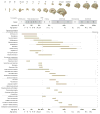The Cellular and Molecular Landscapes of the Developing Human Central Nervous System
- PMID: 26796689
- PMCID: PMC4959909
- DOI: 10.1016/j.neuron.2015.12.008
The Cellular and Molecular Landscapes of the Developing Human Central Nervous System
Abstract
The human CNS follows a pattern of development typical of all mammals, but certain neurodevelopmental features are highly derived. Building the human CNS requires the precise orchestration and coordination of myriad molecular and cellular processes across a staggering array of cell types and over a long period of time. Dysregulation of these processes affects the structure and function of the CNS and can lead to neurological or psychiatric disorders. Recent technological advances and increased focus on human neurodevelopment have enabled a more comprehensive characterization of the human CNS and its development in both health and disease. The aim of this review is to highlight recent advancements in our understanding of the molecular and cellular landscapes of the developing human CNS, with focus on the cerebral neocortex, and the insights these findings provide into human neural evolution, function, and dysfunction.
Keywords: brain development; developmental milestones; evolution; genomics; lateralization; neurodevelopmental disorders; regulatory elements; species differences; transcription factor.
Copyright © 2016 Elsevier Inc. All rights reserved.
Conflict of interest statement
The authors declare no conflicts of interest.
Figures







References
-
- Aldama J. Cytoarchitektonik der Großhirnrinde eines 5 jährigen und eines 1 jährigen Kindes. Z Ges Neurol Psychiat. 1930;130:532–626.
-
- Amsterdam B. Mirror self-image reactions before age two. Dev Psychobiol. 1972;5:297–305. - PubMed
-
- Amunts K, Schleicher A, Ditterich A, Zilles K. Broca’s region: cytoarchitectonic asymmetry and developmental changes. J Comp Neurol. 2003;465:72–89. - PubMed
-
- Azevedo FA, Carvalho LR, Grinberg LT, Farfel JM, Ferretti RE, Leite RE, Jacob Filho W, Lent R, Herculano-Houzel S. Equal numbers of neuronal and nonneuronal cells make the human brain an isometrically scaled-up primate brain. J Comp Neurol. 2009;513:532–541. - PubMed
Publication types
MeSH terms
Grants and funding
LinkOut - more resources
Full Text Sources
Other Literature Sources

